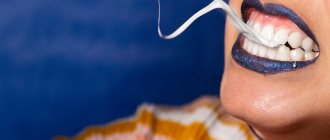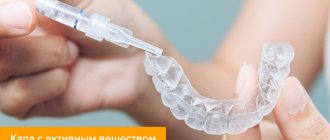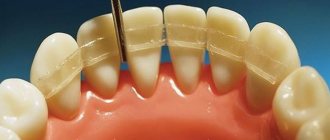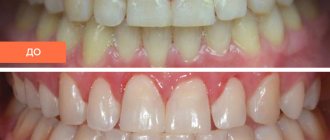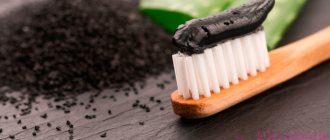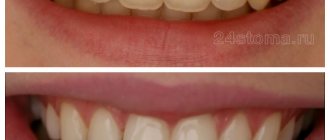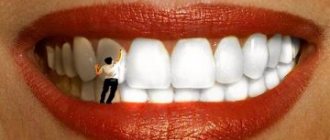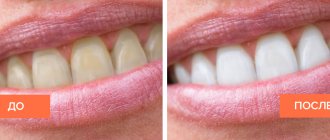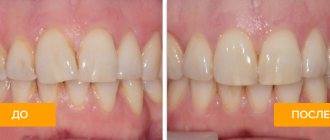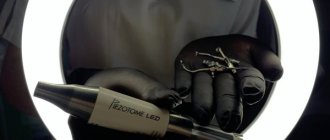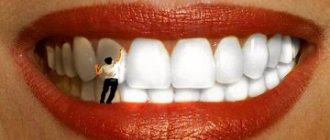Advantages and disadvantages of the procedure
Positive sides:
- Quick results. In a single visit, you can noticeably lighten the enamel by several tones, the effect depends on its condition.
- No medical indications. The client of the dental clinic decides for himself whether he needs to whiten his teeth.
- Many methods with different effects and prices.
- No pain or other discomfort.
- Almost all methods are universal, which means they can be used for patients of different ages.
- There is no need to go through a recovery period.
- Getting rid of complexes and awkwardness when communicating with others.
The technique also has negative aspects:
- The most effective methods have a high cost.
- The effect does not last long. The smile will remain snow-white for 5-7 years, but no more.
- Increased sensitivity of enamel, its thinning. Pain may occur while eating if the food or water is too cold or too hot.
- Inability to change the color of filling material, implants, artificial crowns.
- The risk of losing the natural shade of teeth and excessive whiteness increases.
- The need to adhere to dietary nutrition to maintain results. It is not recommended to drink coffee, strong black tea, or eat foods with a high concentration of bright natural pigment.
Professional approach
Our clinic prefers the OPALESCENCE whitening system manufactured by Ultradent. We also use in practice and offer patients Rembrandt oral hygiene products. Opalescence, Rembrandt and Colgate are among the few whitening systems that are recognized and trademarked by the American Dental Association (ADA). The Opalescence teeth whitening system is registered by the Ministry of Health of the Russian Federation. Opalescence gel contains 20% water, which helps to avoid hypersensitivity or reduce it, without drying out or dehydrating the enamel. The active ingredient in the Opalescence system is carbamide peroxide. Whitening pastes contain various flavoring additives - neutral, banana, menthol and watermelon flavors. Various concentrations of urea peroxide are available (Opalescence 10%, 15%, 20%) with and without fluorine. 35% Opalescence X-tra with carotene is intended for whitening only in the doctor's chair. The procedure for using the home version of Opalescence is not complicated, but requires strict adherence to the instructions. On the first visit, the dentist determines the initial color of the teeth, studies the medical history, removes dental plaque, and takes impressions of the dentition for subsequent production in the laboratory of individual aligner reservoirs in which the whitening gel will be placed. On the second visit, the mouth guards are tried on, they are adjusted, the patient is taught the technique of applying the gel, the procedure for use, the daily or night protocol for use is explained, and a particular toothpaste is recommended. On the third visit, the achieved result is assessed. The whitening effect is comfortable for the patient and others when the shade of the teeth is lightened by 2-4 tones. Attention!
Filling materials are not bleached. Old fillings need to be replaced, since the whitened teeth will be much lighter, but this should be done no earlier than after 14-15 days. During this time, all cabamide peroxide leaves the tooth tissue, and the shade of the enamel stabilizes. Then you can proceed to the restoration of teeth and select the shade of the composite material that matches the shade of the bleached enamel.
Contraindications to teeth whitening
Doctors recommend completely abandoning the procedure or postponing it indefinitely during pregnancy and breastfeeding, as well as when:
- individual intolerance to the components of the whitening composition;
- the presence of a milk bite that has not changed to a permanent one;
- oncology;
- increased sensitivity of enamel;
- tissue damage due to traumatic exposure or other reasons;
- pulpitis in chronic form;
- orthodontic treatment;
- dental diseases (for example, caries) in the acute phase;
- a large number of fillings, fixed dentures, artificial crowns (possible color balance disturbances, unnatural whiteness of certain areas).
Each case is reviewed by a dentist; the doctor may prohibit lightening of the teeth to avoid adverse reactions. Why do you need teeth whitening if it will lead to irreversible consequences? It is likely that the presence of the above circumstances is not an absolute obstacle to a cosmetic procedure, and in the absence of dangerous risks it can be completed.
What works and what lies?
It is important to remember that whitening is an aesthetic procedure and is only done on healthy, clean teeth and healthy gums. That is, professional hygiene and a week of rest almost always. Fillings and crowns cannot be bleached (replacement in the future), so consultation with a specialist is required.
Contraindications - pregnancy, lactation, children under 18 years of age, not for persons sensitive to light and receiving PUVA therapy, oncology, inflammatory diseases of the oral cavity, as well as chronic diseases without adequate therapy.
I won’t discuss everything that’s popular; those who do it will still stick to their guns and consider themselves the smartest and most special. I will say one thing: the effect is much less than the potential harm. I DO NOT RECOMMEND.
Toothpastes do not whiten, but due to increased abrasiveness they simply remove a certain amount of plaque, that is, they lighten. We use it carefully 1-2 times a week. All statements on pastes are marketing. Yes, some toothpastes may even contain an active component for teeth whitening, but its concept is so small and insignificant that you can only notice the result if you really believe in it, having paid a lot of rubles for this magical paste.
Before absolutely any whitening, you must visit a dentist and consult. Whether it’s gel from AliExpress or strips, it doesn’t matter. You may have enamel defects, stones and inflammation, which are a direct contraindication to whitening.
Whitening strips work when used correctly and rationally, but often their use has side effects in the form of pain and sensitivity. Those who do not follow the course, therefore, do not get results.
Gels and lamps in beautiful packages also work , the effectiveness is approximately the same as from strips. It all depends on the condition of the teeth. If there is abrasion, wedge-shaped defects, it becomes unbearably painful.
Whitening with gels and lamps in beauty salons, in my opinion, is quackery . No one will look into your mouth, they will just smear everything and put it on. They do it on stones and plaque - it’s like doing a manicure with very dirty hands. Burns of the mucous membrane and bleaching for caries are also possible. At best, there is simply no result.
Custom whitening trays made by a dentist are the most effective at-home whitening method, but are more often used to maintain color after professional whitening. An independent visible result is also achievable, but with considerable effort.
How to reduce harmful effects
A dazzling smile does not mean that your teeth are completely healthy. Behind the thin enamel is dentin. It is a structure with yellowish or grayish pigmentation. Whitening uses active chemical compounds that lead to thinning of the enamel layer or damage to its integrity. This also affects the condition of the oral cavity.
To minimize negative consequences, the dentist performs the following actions:
- Conducts a visual inspection and assessment of the condition of hard and soft tissues in the mouth.
- Identifies possible contraindications.
- Selects a safe and effective method of teeth whitening.
- Uses any available methods to diagnose and relieve pathological processes.
What determines the color of teeth
It is believed that the color of the enamel determines the color of a person’s teeth, but in fact this is not entirely true. Tooth enamel can be milky white and translucent. Initially, in young people, it is quite dense and almost does not show through the underlying dentin, which in turn has a yellow, grayish or yellow-brown tint. The thicker the enamel, the whiter the teeth. The converse is also true.
Over the course of a person's life, the enamel becomes thinner and the color of the dentin appears. Hence the yellow or grayish smiles of older people. Food, drinks and tobacco also contribute to the darkening of teeth. Don’t forget about dental plaque and tartar, which absorb pigments much more strongly than enamel due to their porous structure.
A sudden change in the color of one or more teeth may indicate the presence of a disease. Thus, with fluorosis, teeth may acquire a brownish tint with whitish spots or stripes. Gray color occurs in pulpless teeth or may indicate heavy metal poisoning.
How to keep your teeth white longer
Depending on the technique used, the effect of professional whitening can last for more than one year. However, some patients return to the clinic after a few months for a repeat procedure. To ensure that your smile remains dazzling for a long time, doctors recommend adhering to the following rules:
- do not eat for 3 hours after teeth whitening, you can only drink clean water, then you must adhere to a special diet;
- Do not use a brush with hard bristles, as this will only increase sensitivity;
- purchase a paste without abrasive particles;
- rinse your mouth, use dental floss, and irrigator after each meal;
- Mouth rinses should not contain chlorhexidine (it stains teeth);
- follow a schedule of visits to the dentist for preventive examinations (at least once every six months);
- complete smoking cessation for 2-3 days, preferably for several weeks.
Special diet
To maintain the effect for a long time immediately after the procedure, you must adhere to a special diet. It is important to minimize the consumption of foods with bright colors. It is advisable to eat:
- porridge;
- dairy (but not fermented milk) products;
- fish and seafood;
- chicken, rabbit;
- egg white;
- white fruits and vegetables (such as bananas).
Along with eliminating food containing dyes from the diet, it is recommended to avoid coloring spices. This is turmeric, paprika. Dentists also do not advise eating smoked meats, citrus fruits, any berries, drinking coffee, black tea and alcoholic beverages.
Why can't you whiten your teeth?
Contraindications to teeth whitening are: - the presence of an allergic reaction to hydrogen peroxide or other components of the drug used for whitening; - lightening of superficial pigment spots, which can be easily removed with professional teeth cleaning and proper oral hygiene; — a large number of carious areas, defective fillings, periodontal diseases in the active stage, abundant dental plaque (in this case, you must first undergo oral sanitation); - pregnancy or breastfeeding; - excessively enlarged pulp chamber. Not recommended for children and teenagers.
Types of teeth whitening: pros and cons
There are no ideal lightening methods. Each has positive and negative sides that the patient must be prepared for. This is why you need to consult your dentist first.
Mouthguards
These are removable devices that are made of special materials that are not subject to oxidative processes. As a rule, structures are used to correct bites and change the position of teeth. If the mouth guard is installed correctly, it does not cause discomfort (pain or other discomfort). After the adaptation period, the patient completely forgets about the presence of a foreign object in the mouth.
The device is created from an impression, which the dentist first makes during the initial appointment. The finished structure is filled with a whitening agent and placed on the upper or lower jaw.
Advantages:
- low cost compared to other methods;
- Possibility of teeth whitening at home.
Flaws:
- insufficient visual effect, mouth guards will not get rid of intense yellowish deposits;
- risk of developing an allergic reaction;
- The method is contraindicated for persons with orthodontic structures in the mouth (plates, braces, etc.).
Laser technique
This method is one of the most effective. You can walk with a snow-white smile for up to 10 years, of course, if you do not ignore medical instructions. In this case, the enamel becomes white in just one session.
A gel composition is applied to the teeth, after which its components are activated using a laser, oxygen ions are formed, which penetrate the enamel layer and deactivate the coloring pigment.
Pros:
- To lighten by more than 5 tones, one visit to the clinic is enough;
- absence of pain and other discomfort;
- the device operates for a short time (about 20 minutes);
- the gel used has antiseptic properties and prevents inflammatory processes in the mouth;
- the components of the drug strengthen the enamel and protect it from external influences.
Negative sides:
- high price compared to alternative methods;
- increased tooth sensitivity immediately after the procedure.
Ultrasonic cleaning
In this case, enamel lightening occurs due to the removal of hard plaque and other deposits, even in the interdental spaces. With the help of vibrations, all layers are mechanically removed. After all the manipulations, the specialist applies a special paste-like composition to the teeth to improve the protection of the dentition from external influences and various chemical irritants.
Ultrasound helps to get rid of even subgingival plaque. The stone is also removed.
Pros:
- in one visit to the dentist you can lighten your teeth several shades;
- during the procedure, the entire oral cavity is cleaned, and not just hard tissues;
- absence of pain and other unpleasant sensations;
- affordable price.
Minuses:
- To consolidate the effect, ultrasonic cleaning should be repeated annually;
- the result may seem insufficient if the enamel is too dark;
- the natural shade of dentin tissue does not change;
- A visit to the doctor takes up to an hour.
Chemical bleaching
The dentist applies highly concentrated preparations that contain hydrogen peroxide or other active ingredients. As a result, dentin is whitened, its shade becomes lighter by 5-7 tones or more.
Advantages of the method:
- an effective procedure that removes plaque and lightens the dentinal layer;
- if all manipulations were performed according to the rules, the result can last up to 4-5 years.
Minuses:
- increased sensitivity of enamel after lightening;
- high price;
- the risk of burns to the mucous membranes if the dosage regimen of the chemical composition is not followed;
- It takes many procedures (about 7) at intervals of 2-3 days to achieve the desired effect.
Air Flow
The surface of the teeth is processed mechanically, without affecting the dentinal layer. The doctor uses a sandblasting machine for this. Even the most difficult to reach areas (for example, interdental spaces) will be clean after exposure to a mixture of water, air and soda. The enamel is polished and the smile becomes dazzling.
Advantages:
- absence of pain and other discomfort;
- the entire oral cavity is cleansed, including the space between the teeth, under the gums, etc.;
- fabrics are not damaged, abrasive particles act very gently;
- the patient is not bothered by increased tooth sensitivity immediately after brushing;
- affordable price.
Minuses:
- insufficiently expressed visual effect;
- a greater number of contraindications compared to alternative methods;
- the color lasts up to a year.
Photobleaching
One of the most modern techniques with ZOOM or Luma-Arch devices. The enamel brightens due to ultraviolet exposure. The lamp warms up the lightening gel applied to the teeth, thereby enhancing its effect.
Pros:
- the procedure lasts about 15 minutes;
- per visit you can make the enamel 10 shades lighter;
- the effect lasts up to 4 years if you follow the rules established by your doctor and adhere to basic hygiene standards;
- absence of pain syndrome.
Minuses:
- high cost (methods involving mechanical cleansing will be much cheaper);
- It is advisable to completely exclude foods with bright dyes from the diet;
- subsequent remineralization may be required;
- before photobleaching, it is necessary to remove microprostheses and veneers;
- bleaching is uneven, hard-to-reach areas are not lightened, but only the front incisors and canines;
- If the procedure technique is not followed, the risk of burns to the mucous membranes of the oral cavity increases.
Endobleaching
This technique is also called in-canal bleaching. This method is used when depulpation has been performed, that is, removal of palpable tissue. After the death of the nerve, the teeth darken, so many patients want to lighten them.
The doctor pours a special synthetic composition with a whitening effect into the cavity and places a temporary filling material on top. If the enamel becomes lighter within 10-15 days, the drug is removed and everything is filled.
Advantages:
- you can lighten one or several teeth at once;
- the enamel remains intact because the whitening agent acts from the inside.
Flaws:
- short-term effect (up to a year);
- not suitable for processing both rows;
- the price increases as the number of teeth treated increases.
Home whitening
Not all patients want to visit a dental clinic and prefer to whiten their enamel at home. The most common procedures:
- The use of special whitening pastes. Typically, such compositions contain abrasives, affecting the entire surface of the dentition. As a result, it is possible to lighten the enamel layer by several tones.
- Special stripes. They resemble a plaster and are glued to the incisors of the upper and lower jaws. The adhesive side contains a gel with concentrated chemical compounds. An oxidation process takes place in the mouth, which promotes quick and easy cleansing.
- Traditional methods. Fans of “grandmother’s” recipes use hydrogen peroxide, soda, activated carbon and other substances.
What are the advantages of self-lightening at home:
- low price;
- ease of implementation.
The list of disadvantages is much more extensive than the list of advantages. This:
- low effectiveness compared to professional care;
- negative impact on enamel, damage to the mucous membranes of the oral cavity, the appearance of hypersensitivity to any irritant;
- high risk of allergies and poisoning due to careless use and, as a result, ingestion of bleaching mixtures.
What is the principle of action of whitening toothpastes?
Alas, as mentioned above, these pastes, like any other, are incapable of changing the color of teeth to a whiter one. Any toothpaste has a largely mechanical effect on the enamel and a very minor effect on chemical, medicinal, etc. In certain cases, with regular use of whitening toothpastes, teeth may actually appear whiter. However, this does not happen due to bleaching, but due to the same mechanical cleaning.
The fact is that most whitening toothpastes are highly abrasive, that is, they contain a large number of abrasive particles. These abrasive particles not only remove soft plaque, as conventional toothpastes do, but also clean off hard plaque, and sometimes even partially remove tartar. It is by removing stained plaque and tartar from the enamel that teeth begin to appear whiter. However, this damages the tooth enamel: abrasives leave microscopic scratches on it, which can later turn into cracks, which leads to tooth destruction.
Is teeth whitening worth it?
This is a very responsible procedure; if you make mistakes, you can start irreversible pathological processes. Doctors recommend dental cleanings twice a year to remove accumulated plaque. This is a superficial method that does not lighten the dentition. If a patient wants to whiten his teeth, he is indicated for professional whitening in dentistry.
Doctors do not recommend performing the procedure at home with store-bought pharmaceutical formulations. Firstly, it is very difficult to correctly calculate the dosage that will be safe for the enamel and for the entire body if accidentally swallowed. Secondly, even one careless action can lead to burns of the mucous membranes.
After lightening the enamel, you need to be prepared for sensitivity to temperature changes, sour, sweet, and solid foods. In addition, careful hygiene and diet will be required, which not everyone is ready for.
Having studied the indications and contraindications for professional cosmetic teeth whitening, the pros and cons of the procedure, you can choose a technique that is right for you. We invite you to sign up for a preliminary consultation with a Dentiki dentist by calling the number listed on the website or filling out the feedback form.
Algorithm of actions for white teeth
So how can you achieve whiter teeth without harming your health? First, you need to decide on the problem: what makes your teeth seem not white enough to you? It is likely that, with your dentin shade and enamel transparency, professional hygiene will be enough to make your teeth appear white.
If, after removing stained plaque, you are still not satisfied with the color of your smile, you need to contact an esthetician dentist, he will select the optimal whitening system for you. However, you need to remember that in some cases even professional whitening may not be effective. The doctor will warn you about this from the very beginning if, for example, you have tetracycline teeth. If the issue of whiteness is so fundamental, in such cases an extreme measure will help - veneering. Veneers and lumineers are permanently thin ceramic linings on the upper front teeth that can not only give them whiteness, but also correct minor unevenness in the dentition and enlarged spaces between the teeth.
How to whiten your smile with a laser
The principle of the technique is somewhat similar to photobleaching - a gel is also applied to the enamel, but it will be activated by a laser (diode or neodymium). The length of the laser beam is specially designed so as not to harm the teeth - not to overheat them and prevent injury. Dentists even note the fact that the laser not only perfectly whitens a smile by 10-15 tones, but also makes the enamel stronger, i.e. protects against caries.
“I finally decided to have laser whitening and it wasn’t a bad choice at all. Three years ago I did Zoom, but after it my teeth ached terribly, to the point of tears. The doctor said that this is a reaction of the body and this happens. But I didn’t need that anymore)) And after the laser, nothing bothered me at all, and my smile just became great.”
Alena, review from the women's forum woman.ru
Tooth enamel whitening at the dentist
For public people, a snow-white smile is an integral part of the image. Modern dental clinics offer a variety of enamel whitening methods:
- Mechanical - using ultrasound or the Air Flow technique.
- Chemical - using laser or ZOOM technology.
The advantages of professional enamel whitening in a dental clinic include a long-term effect: teeth remain white for about a year. The disadvantages are the high cost of services and increased tooth sensitivity after the procedure.
Teeth before and after whitening in dentistry
Which star gave himself a snow-white smile?
It is quite difficult to get an answer to this question from the celebrities themselves. But if you carefully examine the smiles of the stars, it becomes clear that almost every famous person undergoes whitening on a regular basis. And if he doesn’t, then he gets veneers or lumineers to make his appearance even more attractive and not lose popularity. Only a few can boast of ideal white and naturally straight teeth.
If we turn to world stars with a “Hollywood” smile, which they acquired some time after they became very popular, then we can focus on the following personalities - Marilyn Monroe, Tom Cruise, Julia Roberts, Madonna, George Clooney, David Beckham , Emma Watson and many others.
